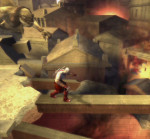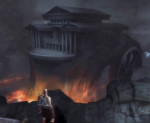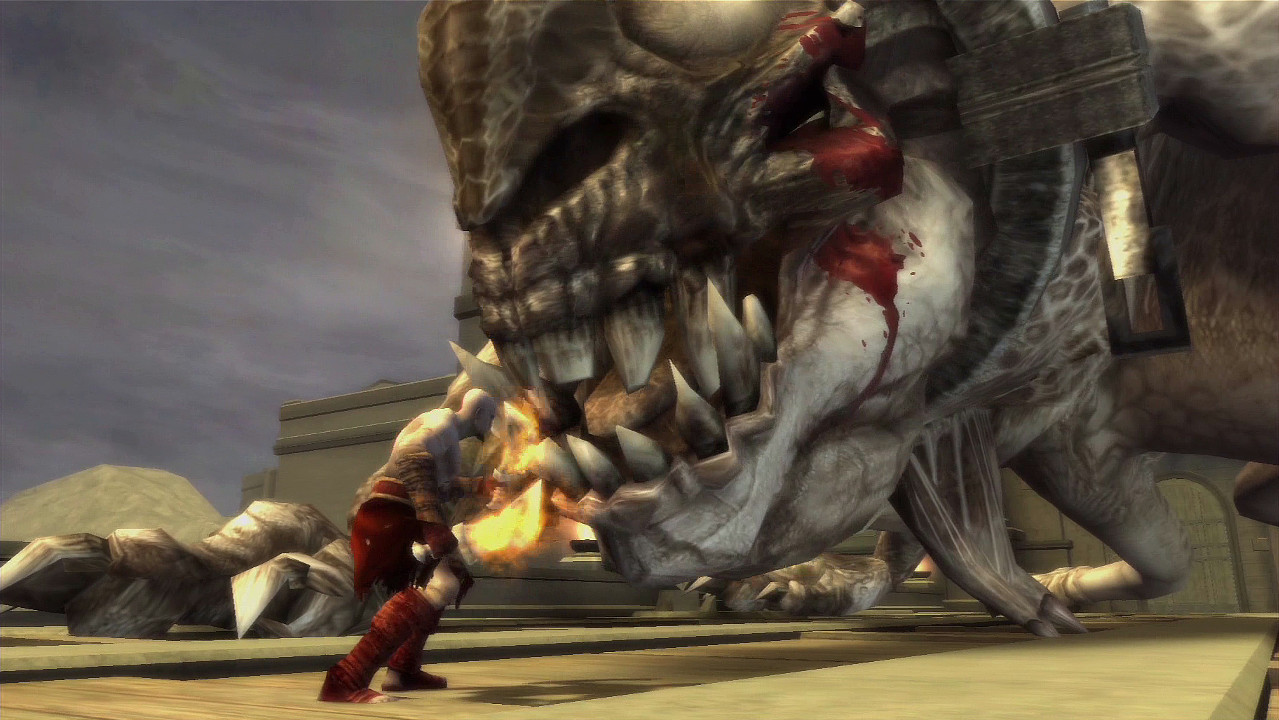PROLOGUE
The game begins in Attica, which is besieged by a Persian army. Kratos had been sent there by the gods to defend it, although one would easily mistake his defense for a rampage. The game doesn’t force you to discriminate between Persian and Attican soldiers; every soldier Kratos runs into ends up dead, anyway. The Persians loose a couple of cyclopses upon Attica, as well as a basilisk, which promptly eats a cyclops (Just as planned?). Kratos fights the basilisk, which retreats after being blinded in one eye. As the basilisk begins rampaging across Attica, Kratos runs down a beach towards the city gates. Of course, the gates are locked because Persians are attacking. Kratos pushes a battering ram up to the gate, while Persian ships fire randomly at the beach. He opens the gate himself, and finds that there are already Persian soldiers inside the city walls, raising even more questions about their battle strategy.

Since this is the first level, there are plenty of helpful tutorial moments here and there. The game introduces you to different controls and mechanics when pertinent, allowing you to grow accustomed to the basic skills without being overwhelmed. In the PS3 version, however, something quite odd occurs during this period. There is a section of the level where Kratos is running across a roof, and encounters a destroyed portion of the building, with a narrow beam spanning the gap. The game tells you how to balance on this beam, and also how to climb back up when a basilisk attack knocks you off. When you reach the end of the beam in the PS3 version, you earn a trophy for having successfully crossed every beam in the game. Huh.

Rather early on, you encounter the king of the Persians. You can tell that he’s in charge, because he’s the tallest of the lot. A brief dialogue ensues, where the king says that his basilisk is cleansing the land, so that it may embrace the glory of the Persian Empire. Because Kratos isn’t the type to question or debate such an insane statement, he fights the king, kills him with treasure, and takes his magic efreet-summoning thingy. The king is now dead, but the war isn’t over; there’s still Persian soldiers running around, not knowing that they’ve lost the battle. Of course, there’s also a one-eyed, poorly-trained basilisk on the loose, just doing whatever it wants.

After following the only road through Attica for a while, Kratos once again confronts the massive basilisk on a pier. This is a brief yet hectic battle, in which Kratos must guard against its biting attacks and jump over streams of fire breath, all while slashing at its face as much as possible. Occasionally, the basilisk will retreat, climb atop a rampart, and lob fireballs at Kratos. Running over to the floating O button near the basilisk’s arm, he climbs up, attaches the blades to the basilisk’s head, and pulls him back down. Then, Kratos pulls down a chunk of a nearby tower, sending it crashing onto the basilisk. When the time comes to finish off the basilisk, Kratos climbs onto its head, pulls up its lower jaw with his blades, and then… something happens. I honestly don’t know exactly what it was. Apparently, there was an explosion, because it sent Kratos flying forward. The “BOOOOOOM!!!!” trophy you get for defeating it seems to back that up. Perhaps the explosion involved the basilisk’s fire breath, but that makes little sense; the basilisk’s mouth wasn’t entirely shut, and fire was constantly leaking out. Even if it was somehow building up fire breath pressure, couldn’t the basilisk just stop it? If the explosion happened in its mouth, shouldn’t Kratos have been blown straight upward? Whatever. All I can glean from this sequence is that Kratos tugged on its lower jaw, an explosion sent him flying forward, and the basilisk plopped over with a dislocated jaw. The mystery physics that tie these effects together are apparently beyond my comprehension. Have a look, and see if you can figure it out:
OK, how about this: Kratos tilts the basilisk’s head upwards while it continues to breathe fire. This somehow forces the basilisk to swallow the fire, which doesn’t mix well with all of the blasting caps it ate earlier. The basilisk’s stomach explodes, and Kratos flies away because he’s Superman. I’m no expert at things that have never happened, but that’s about as plausible as it gets.

Apparently, killing the basilisk was the only thing Kratos was sent there to do. Immediately after that task was checked off, Kratos simply ran away. For all we know, there could still be Persian soldiers and warships attacking the place, but screw them, we’re bailing! So, now that Attica is out of the way, the plot can begin. Yep, this is one of those stories where the first act has absolutely nothing to do with the rest of the game. Kratos, irritated by his service, asks the gods if his service was enough, by screaming at the sky. The sky responds by sending the sun crashing down to earth like a lead parrot. Kratos concludes that this wasn’t a response from the gods, and decides to go investigate the sun crash. He finds the sun, otherwise known as the Temple of Helios, near the city of Marathon.


“Our nipples will blot out the sun…” — Xerxes II, Chamberlain of Skeksis
(10/10, would casually slog through reading the whole thing again.)